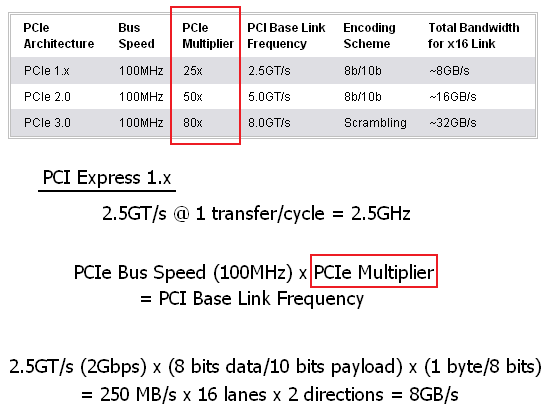PCI Express 2.0: Scalable Interconnect Technology, TNG
by Kris Boughton on January 5, 2008 2:00 AM EST- Posted in
- CPUs
PCI Express Backwards Compatibility
PCI Express is a layered protocol composed of a three distinct partitions: physical (PHY), data link layer (DLL), and transaction layer (TL). This modular approach is what allowed the fundamental change in the physical layer data rate from 2.5GT/s to 5.0GT/s to go unnoticed by the upper layers. The PCI-E bus speed remains unchanged at 100MHz; the only feature that changed is the rate at which data is transferred across the board. This suggests that there is significant signal manipulation required on both the transmit and receive ends of the pipe before data is available for use. In the end, the change is akin to selecting a higher multiplier for a CPU: although the processor operates at an increased frequency, it continues to communicate with the interface component at the same rate. This concept will help us to introduce the concept of a "PCI-E Multiplier." This number is static and cannot be changed (except by the motherboard, which occurs during the training process). PCI Express 3.0 should further increase the PCI-E Multiplier to 80x, which will bring the base link frequency very near the maximum theoretical switching rate for copper (~10Gbps).

As we mentioned before, installing a PCI Express 1.x card in a PCI Express 2.0 compliant slot will result in PCI Express 1.x speeds. The same goes for installing a PCI Express 2.0 card in a PCI Express 1.x compliant slot. In every case, the system will operate at the lowest common speed with the understanding that all PCI-E 2.0 devices must be engineered with the ability to run at legacy PCI-E 1.x speeds.
Unfortunately, there have been some reports of new PCI-E 2.0 graphics cards refusing to POST (Power On Self-Test) in motherboards containing chipsets without PCI Express 2.0 support. We can assure you this is not by design as the PCI-SIG PCI Express 2.0 Specification is very clear on the issue - PCI Express 2.0 is backward-compatible with PCI Express 1.x in every case. With this in mind, and knowing that some PCI Express 1.x motherboards have no problems running the new graphics cards while others do, we have no choice but to blame the board in the case of no video. Unfortunately, this makes it difficult to determine if problems await during the upgrade process; you must first consult with others that use the same video card/motherboard combination. Thankfully the cases of incompatibility seem to be few and far between.










21 Comments
View All Comments
rogerdpack - Monday, July 23, 2012 - link
So shouldn't the article list PCIe 2.0 throughput as 400 MB/s because of the 8b/10b encoding overhead?